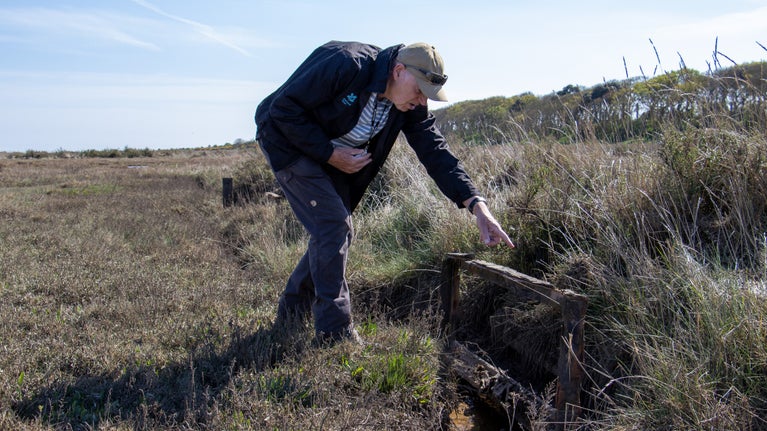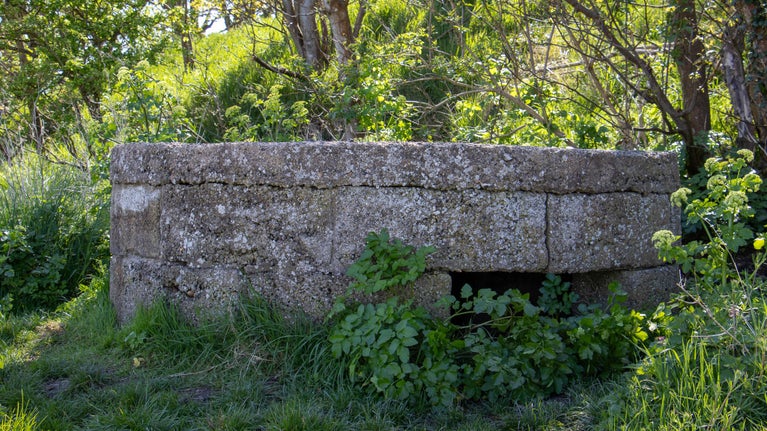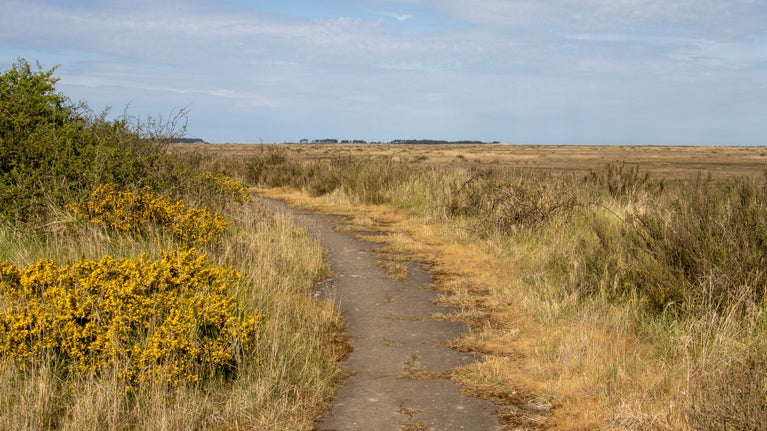HART volunteers shed new light on Stiffkey Marshes’ wartime sites
- Published:
- 16 May 2025

Eighty years on from the end of the Second World War, a team of National Trust volunteers are helping to document and add to our understanding of the military activities that historically took place at Stiffkey Marshes – spanning World War One to the Cold War era.
Stiffkey Marshes, a Site of Special Scientific Interest (SSSI) on the north Norfolk coast, is best known for its precious saltmarsh habitat and the rich birdlife that thrives amid the creeks and sea lavender.
However, during the 1940s and 1950s the peacefulness of the marshes would have been regularly broken by the sound of gunfire – with both British and American armed forces using the wide-open space of the marshes for various types of target practice.
Physical clues about the military history of the area can be found dotted along the edge of the marshes.
Thanks to the efforts of the Heritage and Archaeology Ranger Team (HART) volunteers, information about these sites is carefully recorded and their condition monitored.
This information has been shared with local historians to help date the sites and build up a picture of how they were used.

Stiffkey pillbox
One of the easiest of the sites to spot is a round pillbox which is located just a few metres from the popular Norfolk Coast Path.
It would be reasonable to assume that the pillbox was one of the 28,000 built in Britain as part of anti-invasion preparations during World War Two. However, the pre-cast concrete blocks used in its construction, and its circular shape, point to this pillbox in fact having been part of defences that were put up during World War One.
The Stiffkey pillbox is part of defensive line of 48 World War One pillboxes that ran from Stiffkey to Sea Palling. Today only 24 of the original 48 remain, with the nearest one to Stiffkey being at Muckleburgh.
Hidden rifle range and gun mounts
A short distance away from the pillbox is another military site, but this one – thought to be the remnants of a rifle range used during the Second World War - is almost completely hidden from view. Aerial photos showed a raised area which it was thought may have been part of a sea defence bank dating back as far as the Middle Ages.
However, on closer inspection by the HART volunteers, it appeared that the bank was a much more recent addition to the marshes. Positioned along the bank are five rusting metal structures that are thought to be the bases for target frames. Their position and distance relative to the edge of the marshes strongly suggests that this was a rifle range.
This is consistent with the presence of an army training camp at Stiffkey during World War Two, which is now High Sand Creek Campsite.
To the west of the car park, at the foot of the bank where the footpath rises, are six concrete blocks that were originally thought to have been defensive barriers to slow the progress of enemy tanks.
Analysis of the structures by the HART volunteers showed that they were too small to have been for this purpose. The size and position of holes within the concrete blocks suggest that they were, in fact, gun mounts used by the RAF for anti-aircraft gun training.

A Cold War relic
Further along the Norfolk Coast Path is what appears to be a wide concrete circular path, about 60m in diameter, which is known locally as ‘the whirlygig’.
In the middle is a rusting pole that in the 1950s was the centrepiece of a rotary launcher that was used by United States Air Force personnel who were based at RAF Langham.
The rotary launcher catapulted reduced-scale replica aircraft (known as Radio Controlled Aerial Targets or RCATS) into the sky above the marshes at 85mph, as targets for anti aircraft guns.
These guns are thought to have been fitted with a frame that was known as the ‘Stiffkey Sights’, which essentially allowed the gunner to set their sights to take account of the speed at which the target was travelling, to ensure a hit.
HART volunteers’ role
Neil Oxenbury is one of the National Trust’s HART volunteers who have been helping to record and interpret these archaeological sites at Stiffkey Marshes.
Mr Oxenbury comments: “We’ve just had the 80th anniversary of VE Day and there’s not many people alive now who can remember exactly what happened. So I think it’s important that we understand what’s here. Our role as HART volunteers is to help add to the understanding about these sites and to monitor their condition.”
You can find out more about National Trust archaeological sites in your area by visiting National Trust Heritage Records Online.
You might also be interested in
The Second World War at Blakeney Point
Discover how the wreckage of a Second World War German plane was unearthed at Blakeney Point.

Brancaster Estate and the D-Day landings
Discover the part that Brancaster Beach played in the D-Day landings that took place during the Second World War.

Our work at Blakeney National Nature Reserve
Learn about the work the team at Blakeney National Nature Reserve carries out to preserve this special place for both wildlife and visitors, from counting seals to fence repairs.
